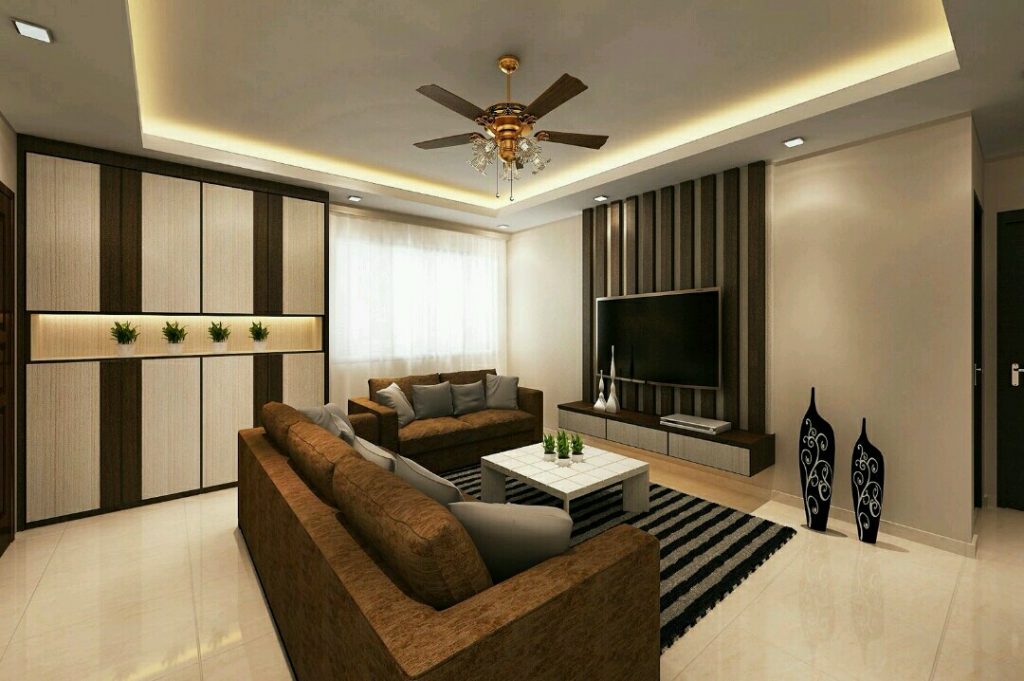
How to Layout Your Living Room in Singapore
The living room is the heart of any home, where family and friends gather to relax and socialize. As such, it’s important to create a comfortable and functional living space that suits your lifestyle and design preferences. However, figuring out the best layout for your living room can be a challenge, especially if you’re working with a small or awkwardly shaped space. In this article, we’ll share expert tips and advice on how to layout your living room in Singapore, so you can create a welcoming and stylish environment that meets your needs.

Assess Your Space
When assessing your living room for furniture placement, it is important to take accurate measurements to ensure that the furniture you select will fit properly and create a comfortable and functional space. To do this, you can follow these steps:
- Measure the length and width of your living room using a tape measure. Be sure to measure from wall to wall and record these measurements.
- Measure the height of your living room from floor to ceiling.
- Determine the size of any architectural elements in your living room, such as a fireplace, built-in shelving, or columns, as these will impact furniture placement.
- Note the location and size of doorways and windows. This will help you determine where furniture can be placed without blocking these important elements.
- Identify the location and number of electrical outlets and determine if additional outlets may be needed for any electronics or lighting.
The significance of these elements in your space assessment is crucial, as they will impact furniture placement and the overall flow and functionality of your living room. For example, if you have a large window or fireplace, you may want to place your sofa or chairs facing it to create a focal point. Additionally, if you have limited electrical outlets, you may need to plan for the placement of additional lighting or extension cords.

Determine Your Purpose and Style
When designing your living room, it is important to identify its purpose and style, as this will guide your selection of furniture and decor. Here are some steps you can follow:
- Consider how you use your living room. Do you use it primarily for entertaining guests, for relaxing with your family, or as a multipurpose space? This will help you determine the type of furniture and decor you need.
- Determine your style preferences. Do you prefer a modern or traditional look? Do you like bold colors or neutral tones? This will help you select furniture and decor that reflect your personal style.
- Create a budget. This will help you narrow down your options and ensure that you can afford the furniture and decor you need.
In Singapore, there are several common living room styles:
- Minimalist: This style emphasizes simplicity and functionality, with a focus on clean lines and neutral colors. Furniture is often sleek and unadorned, and decor is kept to a minimum.
- Scandinavian: This style is characterized by a cozy, comfortable vibe with an emphasis on natural materials and a neutral color palette. Furniture is often made of wood or leather and features clean lines.
- Eclectic: This style mixes different design elements to create a unique and personalized space. Furniture and decor are often sourced from a variety of styles and eras, and bold colors and patterns are common.

Plan Your Furniture Layout
Planning your furniture layout is an essential step in designing a functional and comfortable living room. Here are some different furniture layout options to consider:
- Symmetrical: This layout involves placing identical furniture pieces on either side of a central point, such as a fireplace or TV. This creates a balanced and cohesive look.
- Asymmetrical: This layout involves placing furniture in a less structured and more organic arrangement. This can create a more relaxed and informal feel to the space.
- Floating: This layout involves placing furniture away from the walls, creating a more open and spacious feel to the room. This can be useful in smaller living rooms.
When choosing furniture sizes and shapes, there are some tips to consider:
- Measure your living room carefully to ensure that your furniture fits comfortably and doesn’t obstruct any doorways or windows.
- Choose furniture that is appropriately sized for the space. Oversized furniture can make a room feel cramped, while furniture that is too small can make a room feel empty.
- Consider the shape of your furniture. Rounded edges can soften the look of a room, while angular furniture can create a more modern and structured feel.
- Think about the function of your furniture. For example, if you plan to use your sofa primarily for lounging, choose one with deep cushions and a low profile.
Consider Traffic Flow and Functionality
When designing a living room, it’s important to consider traffic flow and functionality to create a space that is both comfortable and practical. Here are some tips to help you achieve this:
- Create clear pathways: Ensure that there is enough space for foot traffic to move through the room without obstruction. Consider the main entry and exit points and plan your furniture layout accordingly.
- Identify the room’s functions: Determine the primary activities that will take place in your living room, such as TV viewing, reading, or socializing. This will help you select furniture and decor that support these activities.
- Zone your space: Divide your living room into different zones to create a more functional and organized space. For example, you could create a TV viewing area, a reading nook, and a conversation area.
Here are some examples of furniture placement for specific living room functions:
- TV viewing: Place your sofa or sectional facing the TV, with a coffee table in front for drinks and snacks. Add comfortable chairs or recliners for additional seating.
- Reading: Create a cozy reading nook by placing a comfortable armchair or chaise lounge in a quiet corner of the room. Add a side table for books and a lamp for reading.
- Socializing: Arrange your furniture in a way that encourages conversation, such as placing chairs facing each other or creating a circular seating arrangement. Add a coffee table or ottoman in the center for drinks and snacks.

Add Finishing Touches
Incorporating decor elements is an important step in completing your living room design. Here are some tips on how to add finishing touches to your space:
- Rugs: Adding a rug can help define different zones in your living room and anchor your furniture layout. Choose a rug that compliments your living room style and is appropriately sized for the space.
- Curtains: Curtains can add a decorative touch to your living room while also providing privacy and controlling the amount of natural light. Choose curtains that complement your living room style and color scheme.
- Lighting: Lighting can help create ambiance and highlight different areas of your living room. Consider adding a combination of overhead lighting, table lamps, and floor lamps to provide different levels of illumination.
Here are some tips on selecting the right decor pieces to complement your living room style and layout:
- Choose decor that compliments your living room style: Select decor pieces that match the overall aesthetic of your living room, such as modern or traditional.
- Consider color: Choose decor pieces that complement your living room color scheme. This can help tie the room together and create a cohesive look.
- Think about scale and proportion: Select decor pieces that are appropriately sized for your living room. Oversized decor can make a room feel cluttered, while small decor pieces can get lost in the space.
- Add personal touches: Incorporate decor pieces that reflect your personal style and interests, such as artwork or decorative objects.
In conclusion
The layout of your living room plays a crucial role in creating a comfortable and functional space that reflects your style and meets your needs. By following the tips and advice outlined in this article, you can design a living room layout that maximizes your available space, enhances your decor, and creates a welcoming environment for you and your guests. Whether you’re working with a small or large space, there are many creative ways to layout your living room to make the most of every square inch. With some careful planning and thoughtful design choices, you can create a living room that truly feels like home.

Renovate your house with Interior Times!
Interior Times is the answer for you, If you are looking for a luxury place to live, then the home you choose should be the best in every way. Your home should look good, but it also should feel good. It is best for the experienced and professional team from Interior Times to avoid any unwanted results and problems in the end due to inexperienced interior design firms. Here are the things that you can get with our service:
- A leader in the luxury housing sector for commercial and private use
- Different renovation packages for all our clients
- Increasing the value of your property and ensure its future-proofed for future buyers
No need to hassle in renovating your dream house. Contact us here to get more information or visit our showroom at 3 Ang Mo Kio Street 62 #01-08 Link @ AMK , Singapore 569139.
Frequently asked Question
1) What are some common living room layout options?
A: There are several common living room layout options, including the L-shaped layout, U-shaped layout, and open-concept layout. The best layout for your living room will depend on the size and shape of your space, as well as your personal preferences and needs.
2) How can I make the most of a small living room space?
A: If you’re working with a small living room space, there are several layout strategies you can use to make the most of your available square footage. Consider using multi-functional furniture, such as a sofa bed or storage ottoman, to maximize your space. You can also use vertical space, such as wall-mounted shelves or hanging planters, to create visual interest without taking up floor space.
3) What are some tips for arranging furniture in a living room?
A: When arranging furniture in your living room, consider creating a focal point, such as a fireplace or large window, and arranging your furniture around it. Avoid placing furniture directly against walls, as this can create a disconnected and awkward layout. Instead, try to create a sense of flow and balance by grouping furniture together and leaving enough space for people to move around comfortably.
4) How can I incorporate storage into my living room layout?
A: Incorporating storage into your living room layout is essential for keeping your space organized and clutter-free. Consider using built-in shelving or bookcases, storage ottomans, or a console table with drawers. You can also use decorative baskets or boxes to store smaller items, such as remote controls or magazines.
5) How can I create a cozy and inviting living room layout?
A: To create a cozy and inviting living room layout, consider using soft, comfortable fabrics, such as plush throw pillows or a cozy area rug. You can also add ambient lighting, such as table lamps or floor lamps, to create a warm and welcoming atmosphere. Incorporating natural elements, such as plants or natural wood accents, can also help create a cozy and inviting space.
